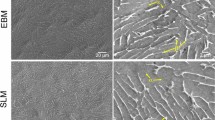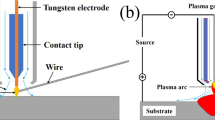Abstract
The feasibility of bonding amorphous ribbons via explosive welding (EW) is demonstrated. With 20–120 layers of Fe78B13Si9 and Fe40Ni40P14B6 amorphous ribbons 25 µm thick and 10 cm wide, the plate samples are bonded by using two setups with a collision point velocity of 3900–4800 m/sec and a flyer plate velocity of 570–900 m/sec. The largest area of the bonded sample is 30 cm2. The microstructures of the samples are observed by optical microscopy and X-ray diffractometry. Based on the formation characteristics of amorphous alloys and heat-exchange characteristics during the EW process, a square-wave model for the temperature distribution across the interface is proposed. It can be used to explain the reasons for the samples keeping the amorphous state across the interface after explosive welding. The calculated results are in good agreement with the experiments.
Similar content being viewed by others
References
A. Kato, H. Horikiri, A. Inoue, and T. Masumoto, “Microstructure and mechanical properties of bulk Mg70Ca10Al20 alloys produced by extrusion of atomized amorphous powders,” Mater. Sci. Eng., 179–180A, 707–711 (1994).
K. Uenishi and K. F. Kobayashi, “Fabrication of bulk amorphous alloy by rolling of mechanically alloyed Al-Cr powders,” Mater. Sci. Eng., 181–182A, 1165–1168 (1994).
M. Takagi, Y. Kawamura, H. Saka, and T. Imura, “Effect of preparation technique and atmosphere on the mechanical properties of bulk amorphous alloy compacts,” Mater. Sci. Eng., 133A, 301–306 (1991).
G. I. Kalandadze, S. O. Shalamberidze, and A. B. Peikrishvili, “Sintering of boron and boron carbide,” J. Solid State Chem., 154, No. 1, 194–198 (2000).
R. S. Averback, H. J. Höfler, H. Hahn, and J. C. Logas, “Sintering and grain growth in nanocrystalline ceramics,” Nanostr. Mater., 1, No. 2, 173–178 (1992).
B. M. Clemens and M. J. Suchoski, “Amorphous iron zirconium formed by solid state reaction,” Appl. Phys. Lett., 47, No. 9, 943–944 (1985).
A. Inoue, Y. Shinohara, and Y. Shinohara, “Preparation of bulky Zr-based amorphous alloys by a zone melting method,” Mater. Trans., JIM, 35, No. 12, 923–926 (1994).
A. Inoue, M. Kohinata, A. P. Tsai, and T. Masumoto, “Mg-Ni-La amorphous alloys with a wide supercooled liquid region,” Mater. Trans., JIM, 30, No. 5, 378–381 (1989).
A. Inoue, T. Zhang, and T. Masumoto, “Al-La-Ni amorphous alloys with a wide supercooled liquid region,” Mater. Trans., JIM, 30, No. 12, 965–972 (1989).
A. Inoue, T. Zhang, and T. Masumoto, “Zr-Al-Ni amorphous alloys with high glass transition temperature and significant supercooled liquid region,” Mater. Trans., JIM, 31, No. 3, 177–193 (1990).
A. Inoue and T. Zhang, “Stabilization of supercooled liquid and bulk glassy alloys in ferrous and non-ferrous systems,” J. Non-Crystal. Solids, 250–252, Part 2, 552–559 (1999).
K. Zhang and X. J. Li, “Study on the multilayer explosive cladding of thin amorphous foils,” J. de Phys., 1, No. C3, 229–234 (1991).
R. Prummer, “Powder compaction,” in: T. Z. Blazynski (ed.), Explosive Welding, Forming, and Compaction, Appl. Sci. Publ, London-New York (1983).
V. F. Nesterenko, Dynamics of Heterogeneous Materials, Springer, New York-Berlin-Heidelberg (2001).
C. F. Cline and R. W. Hopper, “Explosive fabrication of rapidly quenched materials,” Scripta Met., 11, No. 2, 1137–1138 (1977).
D. G. Morris, “The properties of dynamically compacted metglas,” J. Mater. Sci., 17, No. 6, 1789–1794 (1982).
B. H. Shao and K. Zhang, Principle of Explosive Welding and Its Engineering Use, Dalian Eng. Ins. Press, Dalian (1987).
Author information
Authors and Affiliations
Corresponding author
Additional information
__________
Translated from Fizika Goreniya i Vzryva, Vol. 44, No. 4, pp. 130–136, July–August, 2008.
Rights and permissions
About this article
Cite this article
Yan, H.H., Qu, Y.D. & Li, X.J. Explosive welding of multilayer amorphous ribbons. Combust Explos Shock Waves 44, 491–496 (2008). https://doi.org/10.1007/s10573-008-0076-z
Received:
Revised:
Published:
Issue Date:
DOI: https://doi.org/10.1007/s10573-008-0076-z




